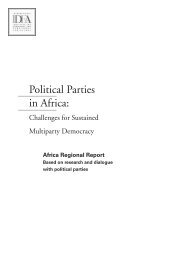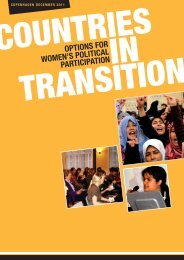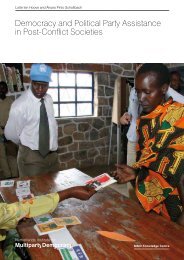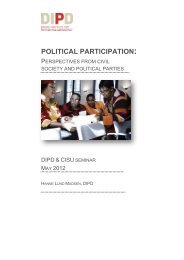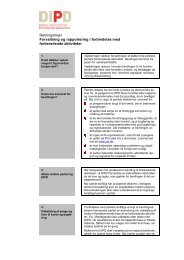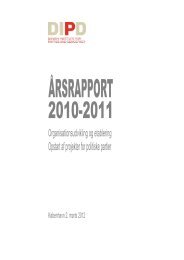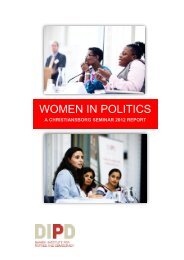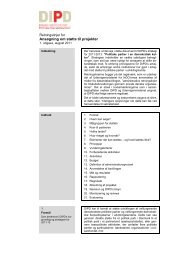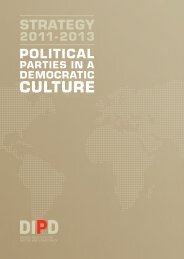Background Document - Danish Institute for Parties and Democracy
Background Document - Danish Institute for Parties and Democracy
Background Document - Danish Institute for Parties and Democracy
Create successful ePaper yourself
Turn your PDF publications into a flip-book with our unique Google optimized e-Paper software.
WOMEN IN LEADERSHIP POSITIONS AT THE LOCAL LEVEL<br />
For women to make a real difference at the local level not only must they enter the<br />
system but must also be prepared to take on the mantle of political leadership. As<br />
Pant <strong>and</strong> Farrell (2009) point out “the pedagogy <strong>for</strong> empowering women politically<br />
<strong>for</strong> leadership roles aims to enhance the capacity of women leaders to underst<strong>and</strong>,<br />
organise <strong>and</strong> act upon their needs, priorities, <strong>and</strong> makes dem<strong>and</strong>s upon the system<br />
<strong>for</strong> better service delivery.”<br />
Drawing on the experience of women being elected through three terms of local<br />
rural <strong>and</strong> urban elections in India they point out that in the first term women got<br />
elected with no precedence or role models <strong>and</strong> since governance was new to them<br />
women stepped back, allowing the men to provide guidance including male members<br />
of the family. 7<br />
In the second term however the community was more accepting of women in<br />
leadership roles with women now using the legitimacy of their elected position to address<br />
several critical issues such as children’s education, drinking water facilities, family<br />
planning facilities, hygiene <strong>and</strong> health, quality of healthcare, roads <strong>and</strong> electricity<br />
in the village areas. They also took the initiative to bring alcohol abuse <strong>and</strong> domestic<br />
violence on to the agenda of political campaigns. 8<br />
The third term of women’s participation in rural <strong>and</strong> urban local bodies in India<br />
saw women leaders become more visible as they became more familiar with the processes<br />
of governance. Despite this change in leadership roles however, women continued<br />
to lack an effective participation base due to gendered identity practices <strong>and</strong><br />
institutional inadequacies.<br />
“Provision of quotas <strong>for</strong> women in local<br />
government has not necessarily created a culture<br />
open to facilitating the participation of women.”<br />
The Indian experience of local elections over the last three decades showed that<br />
while numbers may indicate presence it does not necessarily translate into meaningful<br />
inclusion in the political process as women can be deliberately excluded from the<br />
political process through <strong>for</strong>ce or covert strategies.<br />
In this connection a recent study indicates that an increase in female representation<br />
in local government in India appears to have induced a significant rise in documented<br />
crimes against them, but argue that this is driven by greater reporting of the<br />
crimes rather than an increase in the crimes per se. 9 In another significant finding<br />
they point to the fact that large scale membership of women in local councils also affects<br />
crimes against them more than their presence in leadership positions.<br />
However there is little doubt that violence against women in politics particularly<br />
at the level of local politics has been endemic in not just India but other parts of South<br />
Asia as well. In fact within the community <strong>and</strong> political parties as well there have been<br />
backlashes <strong>for</strong> women who exercise their decision making power <strong>and</strong> the resistance<br />
often from upper caste males can range from threats to attempts of bribery, charges of<br />
7 Pant <strong>and</strong> Farrell (2009).<br />
8 Nambiar <strong>and</strong> B<strong>and</strong>yopadhyay (2004).<br />
9 Iyer et al. (2011).<br />
WOMEN IN POLITICS DANISH INSTITUTE FOR PARTIES AND DEMOCRACY PAGE 31



